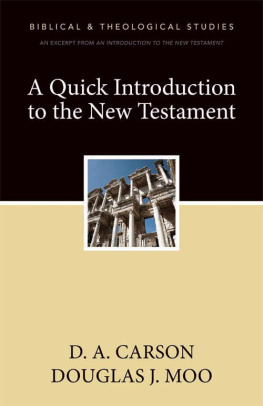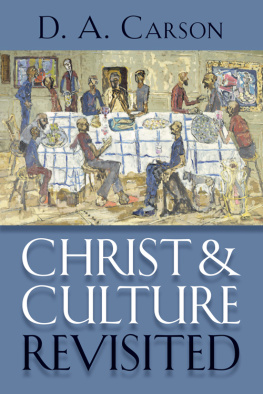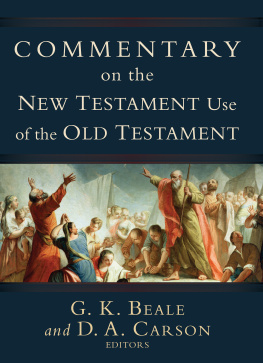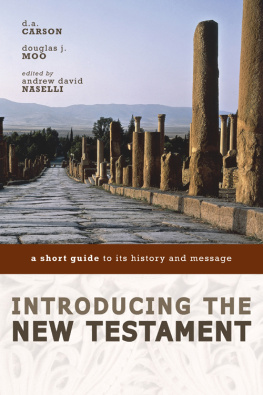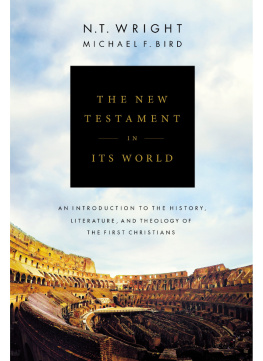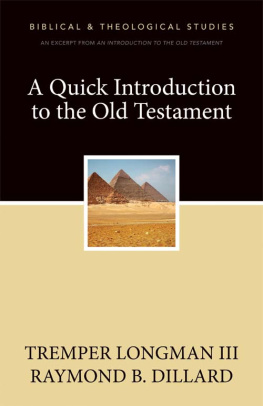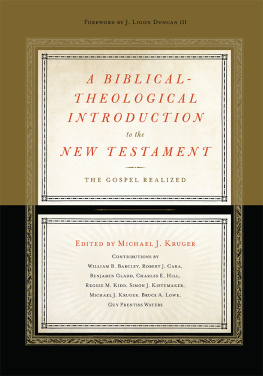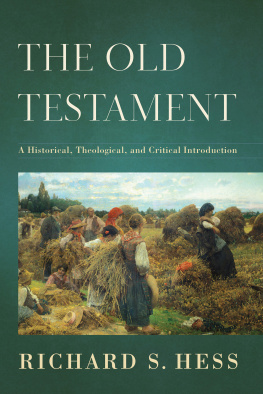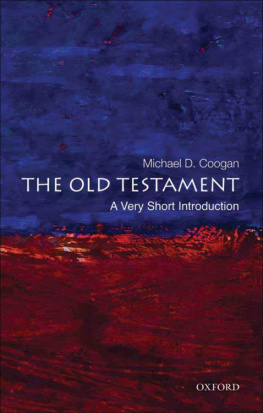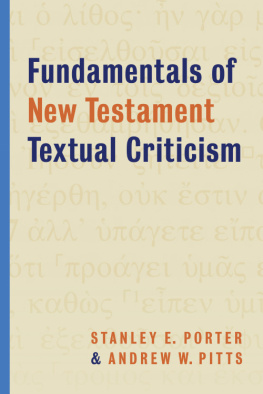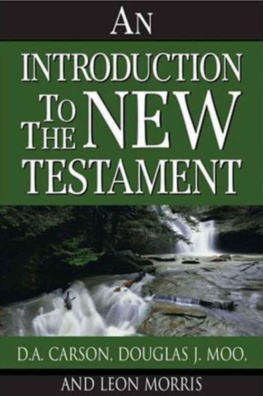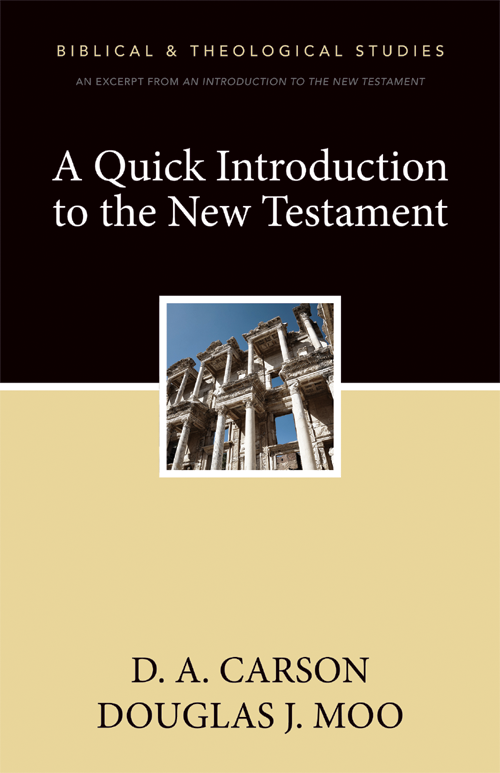CONTENTS
People have been reading and studying the New Testament for as long as its documents have been in existence. Even before all twenty-seven canonical New Testament books were written, some found the interpretation of the available documents more than a little challenging (see the comment of 2 Pet. 3:1516 regarding Paul). A distance of two millennia, not to mention changes of language, culture, and history, have not made the task any easier. The torrential outpouring of commentaries, studies, and essays across the centuries, all designed to explainor in some cases, explain awaythe New Testament documents, makes the task both easier and harder. It is easier because there are many good and stimulating guides; it is harder because the sheer volume of the material, not to mention its thoroughly mixed nature and, frequently, its mutually contradictory content, is profoundly daunting to the student just beginning New Testament study.
This introduction provides little more than a surface history of a selection of the people, movements, issues, and approaches that have shaped the study of the New Testament. The student setting out to come to terms with contemporary study of the New Testament must suddenly confront a bewildering array of new disciplines (e.g., text criticism, historical criticism, hermeneutics), the terminology of new tools (e.g., form criticism, redaction criticism, discourse analysis, postmodern readings), and key figures (e.g., F. C. Baur, J. B. Lightfoot, E. P. Sanders). Students with imagination will instantly grasp that they do not pick up New Testament scrolls as they were dropped from an apostolic hand; they pick up a bound sheaf of documents, printed, and probably in translation. Moreover, the text itself is something that believers and unbelievers alike have been studying and explaining for two millennia.
PASSING ON THE TEXT
At the beginning of his gospel, Luke commentsb that many others had already undertaken to write accounts of Jesus (Luke 1:14). Although some scholars have argued that there was a long period of oral tradition before anything substantial about Jesus or the early church was written down, the evidence is against such a stance: the world into which Jesus was born was highly literate. From such a perspective, the existence of the documents that make up the New Testament canon is scarcely surprising.
These documents were originally hand-written on separate scrolls. There is very good evidence that the writing was in capital letters, without spaces, and with very little punctuation. Printing was still almost a millennium and a half away, so additional copies were made by hand. In theory, this could be done by professional copiers: in a scriptorium, one man would read at dictation speed, several scribes would take down his dictation, and another would check each copy against the original, often using ink of a different color to make the corrections. This kind of professional multiplying of copies was labor-intensive and therefore expensive. Most early Christian copies of the New Testament were doubtless done by laypeople eager to obtain another letter by Paul or a written account of the life, ministry, death, and resurrection of Jesus. That brought the price down: Christians were investing their own time to make their own copies, and they were not having to pay large sums to professional scribes. On the other hand, the private copy made by an eager and well-meaning layperson was likely to include more transcriptional errors than copies made and checked in a scriptorium.
As the numbers of copies of New Testament documents multiplied, three formal changes were soon introduced. First, the scroll gave way to the codex, that is, to a book bound more or less like a modern book, which enabled readers to look up passages very quickly without having to roll down many feet of scroll. Second, increasingly (though certainly not exclusively) the capital letters (scholars call them uncials) gave way to cursive scripts that were messier but much more quickly written. And third, because the early church, even within the Roman Empire, was made up of highly diverse groups, it was not long before the New Testament, and in fact the whole Bible, was translated into other languages. These versions of the Bible (as translations are called) varied widely in quality.soon numerous Latin versions, Syriac versions, and so forth, as individuals or local churches produced what seemed necessary for their own congregations.
Today the printing press churns out thousands of identical copies. When each copy is written by hand, however, if the work is of substantial length, each copy will be a little different than all others because the accidental mistakes introduced by successive copying will not all congregate in the same place. The challenge of producing a copy that is perfectly true to the original soon multiplies. A slightly later Christian, making a copy of a copy, spots what he judges to be mistakes in the manuscript before him and corrects them in his fresh copy. Unfortunately, however, it is possible that some things he thought were mistakes were actually in the original. For instance, it is well known that there are many grammatical anomalies in the book of Revelation. The reason for this is disputed; there are three major theories and several minor ones. But a later copyist might well have thought that errors had been introduced by intervening copyists and corrected them to proper grammarthereby introducing new errors.
Two further accidents of history and geography have helped to determine just what material has come down to us. First, just as the Roman Empire divided between East and West (stemming from the decision of Emperor Constantine to establish an eastern capital in what came to be called Constantinople), so also did the church. In the West, because it was not only the official language of Rome but also tended in time to squeeze out Greek as the lingua franca, Latin soon predominated in the church. Initially, there were many Latin versions, but toward the end of the fourth century, Damasus, Bishop of Rome, commissioned Jerome to prepare an official Latin version that would be widely distributed and sometimes imposed throughout the churches of the West. This Latin version, revised several times, became the Vulgate, which held sway in the West for a millennium. By contrast, Greek dominated in the East, in what eventually became the Byzantine Empire. Inevitably, Greek manuscripts were used and copied much more often under this linguistic heritage than in the West, until Constantinople fell to the Muslim Turks in 1453. Many Eastern scholars then fled West, bringing their Greek manuscripts with thema development that helped to fuel both the Reformation and the Renaissance.
Second, the material on which ancient books were written (i.e., their equivalent of paper) decomposed more readily in some climates than in others. The most expensive books were made of parchment, treated animal skin. Higher quality parchment was called vellum. More commonly, books were made of papyrus, a plant that grew plentifully in the Nile Delta. Papyrus has the constituency of celery or rhubarb. Long strips could be peeled off, pounded, and glued together to make sheets. Although parchment is tougher than papyrus, both materials are organic and thus readily decompose, especially when there is moisture in the atmosphere. So it is not surprising that the best caches of really ancient manuscripts come from the hot, dry sands of Egypt.
ranging from the fourth to the thirteenth century. Similar breakdowns can be put forward for all the versional evidence. Although most of this material springs from the thousand-year period between A.D. 500 and 1500, the earliest fragments come from the first half of the second century.

